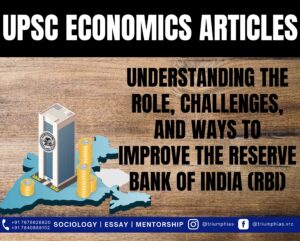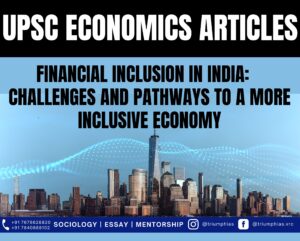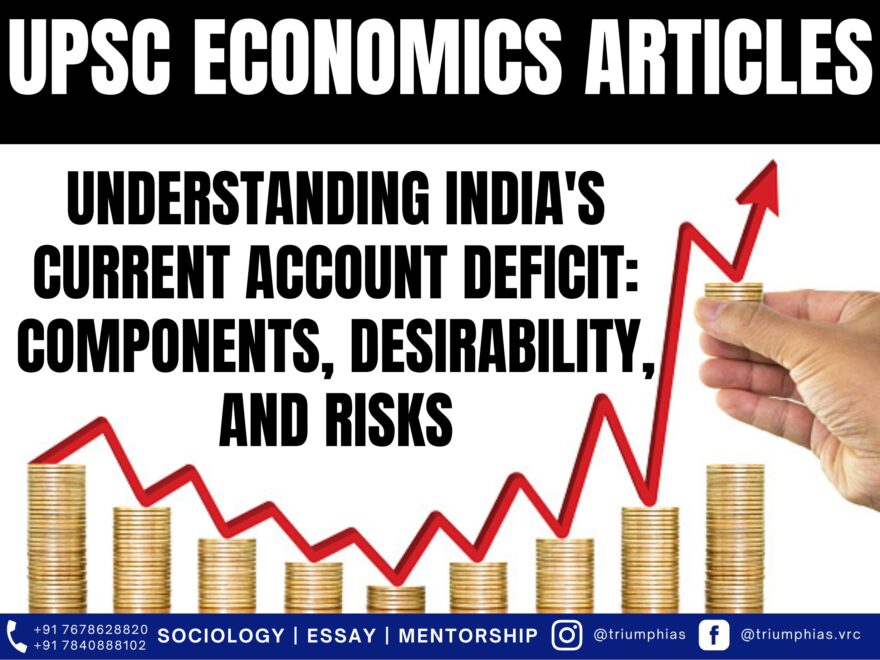Current Account Deficit
(Relevant for Economics Section of General Studies Paper Prelims/Mains)

Current Account Deficit
Current Account Deficit (CAD) can be calculated by summing up Trade Deficit, Net Income, and Net Transfers. The current account holds significant importance within the balance of payments framework, which documents the transactions between a country’s entities and those in other nations. This category encompasses various elements, including a country’s net trade in services and goods, its net earnings from investments across borders (covering interest and dividends), and its net transfer payments like remittances and foreign assistance.
A Current Account Deficit (CAD) arises when the value of imported goods and services surpasses the value of exports. The trade balance specifically pertains to the net difference between a country’s exports and imports in terms of goods or physical merchandise trade.
Components of CAD
Trade Deficit Trade Deficit can be calculated by subtracting Exports from Imports. A nation is considered to have a trade deficit when its imports of goods and services surpass its exports. This economic indicator highlights an imbalance in trade, signifying that a country is bringing in more goods and services than it is shipping out. A trade deficit reflects an outflow of the domestic currency to foreign markets.
Net Income Net Income is derived from the income earned by multinational corporations (MNCs) from their investments within India. When the income from foreign investments exceeds the savings of a country’s residents, a net income deficit occurs. This measure includes payments to foreign entities in the form of dividends from domestic stocks, interest payments on bonds, and wages disbursed to foreign individuals employed within the country.
Net Transfers Net Transfers encompass instances where foreign residents remit money back to their home nations, along with government grants provided to foreigners. This category also covers various financial inflows like remittances, gifts, and donations sent across borders.
India’s CADs have both desirable and undesirable components
- Desirable: A favorable deficit is a natural outcome of increased investments, portfolio preferences, and the demographic structure of the nation. When Current Account Deficits (CADs) can be covered by steady capital inflows, such as Foreign Direct Investments (FDI), they become desirable, as they are less susceptible to sudden withdrawal of capital. Stable capital influxes are sought after because they empower debtor nations like India to channel them into sectors with potential for long-term growth, fostering higher economic development.
- Undesirable: However, significant and persistent CADs can become undesirable if they signal underlying issues like weak export competitiveness and are funded by unreliable sources. If deficits are supported by volatile capital streams like portfolio investments, they might become a cause for concern. Portfolio investments are erratic and more prone to reversals in case of global financial disruptions.
The countercyclical nature of India’s CAD: A matter of concern
Impact of external shocks: Studies indicate that a nation’s Current Account Deficit (CAD) tends to increase when its output experiences a decline, rather than when there’s an increase in demand, underlining the influence of external shocks. For instance: If there’s a surge in oil prices, and since oil serves as a key input in the production cycle, it escalates production costs, resulting in a decrease in economic growth. In such scenarios, CADs expand alongside reduced growth due to the combination of the inelastic nature of oil import demand and its substantial portion within India’s overall imports.
Sample Question for UPSC Sociology Optional Paper:
Question 1: What are the components of India’s Current Account Deficit (CAD)?
Short Answer: The components of India’s CAD include the Trade Deficit, which is the difference between exports and imports; Net Income, which covers earnings from investments and payments to foreign entities; and Net Transfers, that include remittances, gifts, and government grants across borders.
Question 2: What makes a Current Account Deficit (CAD) desirable for India?
Short Answer: A CAD becomes desirable when it is a result of increased investments and can be funded by stable capital inflows like Foreign Direct Investments (FDI). These stable inflows are less prone to sudden withdrawals and can be invested in sectors that promise long-term growth.
Question 3: Why can a persistent Current Account Deficit be a matter of concern?
Short Answer: Persistent CADs can become a concern if they indicate underlying issues like weak export competitiveness and are funded by volatile capital streams, like portfolio investments, which are susceptible to global financial disruptions.
Question 4: Explain the countercyclical nature of India’s CAD.
Short Answer: India’s CAD tends to widen when the economy faces a downturn, rather than an uptick, highlighting its vulnerability to external shocks such as a surge in oil prices.
Question 5: How do external shocks like rising oil prices impact India’s CAD?
Short Answer: A surge in oil prices raises production costs, leading to slowed economic growth. Given the inelastic nature of oil import demand and its significant share in India’s overall imports, this can result in an expanded CAD.
 |
 |
To master these intricacies and fare well in the Sociology Optional Syllabus, aspiring sociologists might benefit from guidance by the Best Sociology Optional Teacher and participation in the Best Sociology Optional Coaching. These avenues provide comprehensive assistance, ensuring a solid understanding of sociology’s diverse methodologies and techniques.
Current Account Deficit, CAD, India, Trade Deficit, Net Income, Net Transfers, Foreign Direct Investment, Portfolio Investment, External Shocks, Economic Growth, Current Account Deficit (CAD), Current Account Deficit,

Choose The Best Sociology Optional Teacher for IAS Preparation?
At the beginning of the journey for Civil Services Examination preparation, many students face a pivotal decision – selecting their optional subject. Questions such as “which optional subject is the best?” and “which optional subject is the most scoring?” frequently come to mind. Choosing the right optional subject, like choosing the best sociology optional teacher, is a subjective yet vital step that requires a thoughtful decision based on facts. A misstep in this crucial decision can indeed prove disastrous.
Ever since the exam pattern was revamped in 2013, the UPSC has eliminated the need for a second optional subject. Now, candidates have to choose only one optional subject for the UPSC Mains, which has two papers of 250 marks each. One of the compelling choices for many has been the sociology optional. However, it’s strongly advised to decide on your optional subject for mains well ahead of time to get sufficient time to complete the syllabus. After all, most students score similarly in General Studies Papers; it’s the score in the optional subject & essay that contributes significantly to the final selection.
“A sound strategy does not rely solely on the popular
Opinion of toppers or famous YouTubers cum teachers.”
It requires understanding one’s ability, interest, and the relevance of the subject, not just for the exam but also for life in general. Hence, when selecting the best sociology teacher, one must consider the usefulness of sociology optional coaching in General Studies, Essay, and Personality Test.
The choice of the optional subject should be based on objective criteria, such as the nature, scope, and size of the syllabus, uniformity and stability in the question pattern, relevance of the syllabic content in daily life in society, and the availability of study material and guidance. For example, choosing the best sociology optional coaching can ensure access to top-quality study materials and experienced teachers. Always remember, the approach of the UPSC optional subject differs from your academic studies of subjects. Therefore, before settling for sociology optional, you need to analyze the syllabus, previous years’ pattern, subject requirements (be it ideal, visionary, numerical, conceptual theoretical), and your comfort level with the subject.
This decision marks a critical point in your UPSC – CSE journey, potentially determining your success in a career in IAS/Civil Services. Therefore, it’s crucial to choose wisely, whether it’s the optional subject or the best sociology optional teacher. Always base your decision on accurate facts, and never let your emotional biases guide your choices. After all, the search for the best sociology optional coaching is about finding the perfect fit for your unique academic needs and aspirations.
To master these intricacies and fare well in the Sociology Optional Syllabus, aspiring sociologists might benefit from guidance by the Best Sociology Optional Teacher and participation in the Best Sociology Optional Coaching. These avenues provide comprehensive assistance, ensuring a solid understanding of sociology’s diverse methodologies and techniques. Sociology, Social theory, Best Sociology Optional Teacher, Best Sociology Optional Coaching, Sociology Optional Syllabus.
Best Sociology Optional Teacher, Sociology Syllabus, Sociology Optional, Sociology Optional Coaching, Best Sociology Optional Coaching, Best Sociology Teacher, Sociology Course, Sociology Teacher, Sociology Foundation, Sociology Foundation Course, Sociology Optional UPSC, Sociology for IAS,
Follow us :


https://t.me/VikashRanjanSociology
Find More Blogs
|
Scope of the subject and comparison with other social sciences |
|||
|
|
|
|
Modernity and social changes in Europe |

